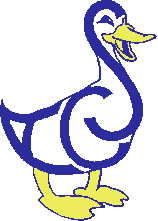We were back in Aylesbury this morning to do a few errands at the Post Office and Bank etc. We had put some washing on before going and when we got back we hung it up as the weather was breezy and warm. After lunch I set to washing the boat. After one side I pulled it over to the other pontoon and did that side too. I even polished the side in the shade. I needed a beer after that.
The Aylesbury Canal Society have a duck, with their initials making up the body, as their logo. Most people will think ducks when they hear Aylesbury mentioned and they were central to the heritage of the town.



The Aylesbury Canal Society have a duck, with their initials making up the body, as their logo. Most people will think ducks when they hear Aylesbury mentioned and they were central to the heritage of the town.

Aylesbury Canal Society logo.
It is often thought that any white duck is an Aylesbury duck, but actually the above logo is not an Aylesbury duck!
Domestic ducks were descended from wild mallard ducks. The odd white ducks were saved and breed and became the English White duck. From about 1690 these were being farmed in Aylesbury. They used selective breeding and produced what became known as the Aylesbury duck. Thorough breed Aylesburies have a pink beak, pure white plumage and yellow legs and feet. They have their legs in the middle of their bodies in the middle of their body, and a deep 'keel' that gives them a boat shop. They fattened up quickly and were large breasted with good flavoured meat. The carcass had white skin. They also laid their eggs in November so that they were able to be on the market from February which was after the end of the game season and before the earliest spring chickens came on the market. The pink bill comes from the local grit that was given them as they require it to aid digestion. The white feathers were also popular for filling pillows and quilts, like at Boston.

Pure bred Aylesbury duck, left and drake, right.
In 1750 there were up to four cart loads of duck carcasses making the 40 mile trip to London every Saturday. When the railway came to Aylesbury in 1839 the markets became even wider and by 1850 about a ton of ducks were sent to Smithfield Market most nights.
The decline for the Aylesbury started by the interbreeding of the ducks causing problems. The problems grew when the Pekin duck was introduced from China at the end of the 1800's. This duck laid more eggs, fattened more quickly and was the same size as an Aylesbury at nine weeks. The down side was that the skin was yellow and the flavour was not as good as the Aylesbury. Pekin ducks have a yellow beak and their legs are at the end of their bodies giving them an upright stance.

A Peking duck.
Inevitably the Aylesbury and the Peking were cross bred and the resulting duck was hardier and much cheaper to raise. The days of the pure bred Aylesbury were numbered and by the end of WWI the big increase in price of feed and the competition from other breeds, plus the fact that the demand for luxury foods like duck fell away. The shortage of feed again after WWII saw the end of farming of the Aylesbury duck.
How ever some survived and they are now becoming popular again due to their delicate taste and white skin and the search for locally sourced foods, and many restaurants are now trying to use the Aylesbury duck. I don't think that we will be seeing flocks of ducks with cold tar and sawdust on the feet to provide 'shoes' being herded to London.
No comments:
Post a Comment